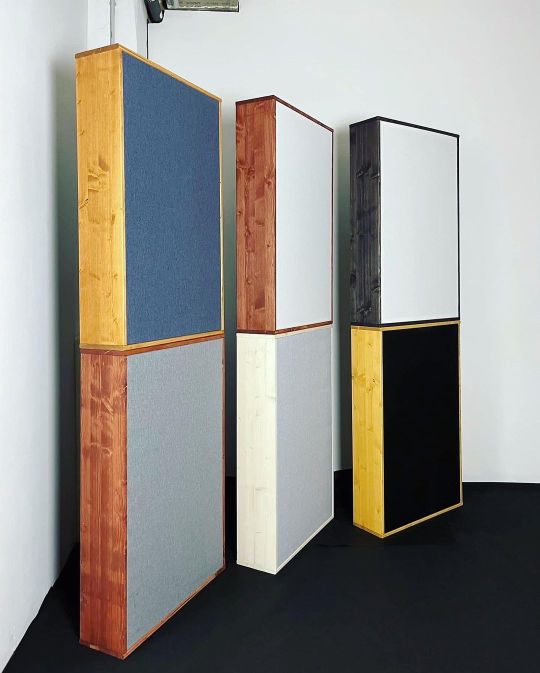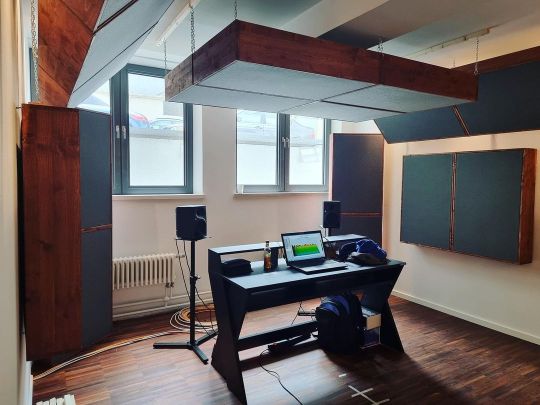#kissyourears
Explore tagged Tumblr posts
Photo

Z E B R A S T U D I O | Berlin
Acoustic treatment by Kiss Your Ears
#Berlin#kissyourears#studio#flstudio#recording studio#home studio#producers#producer#audio production#music producers#bedroom producer#musician#electronic music#techno music#techno#audio equipment#audio producer#audio gear#synths#synth#synthesizer#synthesizers#GENELEC#zebra stripes
107 notes
·
View notes
Text
Soundrs: Kiss Your Ears

Kiss Your Ears is a Berlin based and Europe wide company focusing on offering better quality and far more affordable acoustic treatment for any kind of music studio. If there’s a problem with acoustics in your room, KYE can fix it - or guide you how to do so yourself DIY. Their website is a remarkable resource for learning about room acoustics, made simple for the average music producer. Go have a look at their Instagram full of glorious music studios!
➜ https://www.kissyourears.com/
➜ https://www.instagram.com/kissyourears/

Jon is the founder of Kiss your Ears
As an introduction please tell us a bit about yourself and the work that you are doing.
I am an entrepreneur working with concepts that create positive change in the music industry.
I have created Kiss Your Ears, an acoustic treatment manufacturing company that has been designed to offer much better quality acoustic treatment than what is otherwise available, and at a very competitive price point. We are also the only acoustic treatment company specialised in the requirements of electronic music production, aka. hitting those low frequencies that are left resonant by other available units.
I have also built 73 high quality music production studios in Berlin, which I rent out with different companies across three buildings in different locations in the city, offering creative communities for producers to benefit from.
Next, I will finish the book I'm currently writing, Kiss Your Ears: A Practical Guide to Acoustics for the Modern Music Maker. I will simplify some often confused topics, and give away build plans for all kinds of acoustic treatment modules as well as plans for affordable isolative constructions aka. Room-in-Room-in-Budget solutions. I aim to give away the answer to every single problem I have ever encountered in building and treating studios.
I am also in the process of starting a new company focused solely on office acoustics worldwide, and plan to hit that with the same innovative and value oriented mindset that KYE has benefited from.
What is music to you? (Or sound rather.)
Music is sharing. Sound is energy (vibrations).
How did you learn about studio acoustics?
It has been a long process.
I am thorough. I did some serious research and took some risks (large investments for research).
I decided to equip myself with the most thorough and relevant/ applicable skill set by studying in some small apprenticeships, I studied formally and in my own time, and served my 10.000 hours by helping hundreds of clients save a lot of money on their studio set ups.
I've actually served my ten thousand hours more than once if we count that my achievements as a musician, music producer and construction professional have been racking up for many years…
I am now writing the book that will teach the average producer how to do what I do and treat rooms the right way!
youtube
Studio Acoustics: The Basics | ADAM Audio & Kiss Your Ears
Why does it matter?
Why does Room Acoustics matter? Because in an untreated room, you are listening more to the room itself than what is actually coming out of your speakers!
Acoustic treatment is a tool like any other, and an important one at that. You can save a lot of time with a well treated room!
People don't even realize how much of an effect proper acoustics treatment can have because it was not commercially available before.
How common is it nowadays for electronic music producers to mix and master their own work?
I would say around 90% of electronic music producers mix their own music. This is less in the area of "modern singer songwriter" and more in the area of "producer/ DJ".
In the professional arena, even those that do their own mixdowns do not master their own tracks. That is a folly.

aesthetically pleasing acoustic room treatment
What is the most common problem that you encounter in untreated rooms/home studios?
The most common problems we encounter in untreated rooms/ home studios are that the client has already wasted some of their budget on far lesser performing acoustic elements. For example, I quite often see clients with thin (10-15cm) absorbers in a music production environment.
Also quite often, I see people fetishizing the "cloud placement" absorbers for no real reason, as well as buying diffusers before they have taken care of the low frequency resonances.
This is all because of the misinformation spread around freely about room acoustics even on reputable forums.
Tell us a bit about the measuring process, is it exciting and adventurous? What sounds are you using?
To be honest, the measuring itself is not so exciting, and in fact highly predictable. However, getting to help clients with their sacred spaces is highly rewarding.
We would normally use full frequency spectrum sine wave sweeps.
Do you trust your ears or your visualizer?
Well, you don't really hear sub bass as much as feel it so…
That said, I have relative pitch from playing instruments and I've looked at a lot of data so when I go into a room and hear a kick drum that is activating a 60Hz resonance in the room, I hear the B note…
But I would say I use both, and always trust the data because the data cannot lie. Our psychoacoustic perception can and does!

behold their legendary bass traps!
Why are the KYE absorbers called King Kong?
Because they are the most effective on the market! They are also the most affordable solution to achieving the 80/20 rule of high end results, so they required a legendary name!
The build quality is also far superior to the rest of the market. These monkeys are big boned.
We do have other ranges, but the King Kong Range is our best seller.
Is it all about the bass traps, i. e. fix the bass, fix the room?
Due to space and budget limitations, absorption is almost ALWAYS the most important factor in the control of room acoustics.
The theory behind the system we follow is to always use the input budget to prioritise fixing the low end (thereby fixing most of the rooms’ other issues along the way). Low frequency control is a widely misunderstood and somewhat mysterious practice.
How to do it properly? Start with a low reaching velocity absorber and hit the bass broadband/wideband as much as possible until exhausted. Again, that’s how the pro’s do it and it’s just logical. If our budget stops there, then that is the best use of it.
In order to achieve a more even reverb time across the frequency spectrum, you should use the same traps for both functions (“bass trapping” diagonally over corners and “early reflections” covering certain wall areas).
Do you think it’s possible to trust digitally adjusted monitor speakers in an untreated room, with software like Sonarworks for example?
Sonarworks in particular is a very contemporary software package that works beautifully as this piece of the puzzle. It is almost a matter of taste. Sonarworks and other digital solutions do not compensate for the dimension of TIME - therefore resonances must be solved first- but it is recommended as a final step after the bass traps handle the room’s resonances. Without adding the bass traps first, you may end up in a messy and confusing situation!
What is the ideal listening level for mixing, producing, mastering?
Around 85 dB SPL.
Should audiophiles who only enjoy listening to music care about room treatment, too?
Only if they want to hear the music without the room. Again, in an untreated room, you are listening to the room more than the music because of the way the room "colours" the sound.
Can a music producer not just use headphones and ditch room acoustics altogether?
Acoustic treatment will save a producer A LOT of time. Most processes can be done maybe 50% faster if endless referencing is not needed and they can fully trust that what they hear is what is coming out of the speakers. It's of course optional. Some producers still seem to prefer to struggle on without it! Ignorance is bliss…
Headphones will not create the soundstage achievable with a properly acoustically treated room, which is not even that hard to achieve thanks to the innovative processes suggested by Kiss Your Ears. I would always suggest to someone that works primarily in headphones to go check their mixes in a properly treated room.
As an ideal fantasy, what would be the best room form for linear sound reproduction? Would it be an anechoic chamber?
I guess technically speaking, an anechoic chamber would lead to the most "linear" sound but looking for a linear SPL is not always the most important aspect of a room's sound.

Absorbers that tie the room together. No need for a carpet!
Want to drop some famous names of musicians, producers, engineers who Kiss Your Ears did room treatment for?
DVS1, Peggy Gou, Fjaak, Clouds, Hainbach, Mogwai, Palms Trax, Headless Horseman, D.Dan, Kamikaze Space Programme, Blush Response, ItaloJohnson, Ben Rau, Objekt… and companies like Elektron, Pioneer, Moog… and 500+ others!
What is one of the worst tips about studio acoustics that‘s floating around the internet, on YouTube, etc?
Wow, where do I start? Most of the "tips" online are problematic in some way or other.
I'll give you some blunt statements!
Tri-traps are an ineffective design.
Cylinder traps don't work properly.
Foam based products are inferior.
Putting diffusers at the back of the room (lowest axial mode) is a bad choice.
Those are four things that almost all acoustic treatment companies are getting wrong on a daily basis!
How much does it matter what kind or brand of monitor speakers producers use? Is more expensive more better? Can you recommend good monitor speakers (for different budgets)?
Putting expensive monitors in an untreated room is a false economy. You would be better off treating the room to a good level and getting old 80s Hi Fi speakers from ebay!
An old industry rule of thumb is that you should spend as much on your acoustic treatment as your monitors.
If you are prepared to spend some cash, I think HEDD offer incredible value in their lower range. The HEDD type 07s are amazing for the price when you want to spend around € 2.000.
Then when you want to upgrade and spend more, like € 6.000: I recommend the Adam S3Vs… For the price, those are next level. But they put out some sub bass power, so proper bass treatment is essential.
#soundrs#KISS YOUR EARS#interview#studio acoustics#acoustic#Sound#Sound Healing#studio#recording studio#home studio#music studio#electronic music#king kong#room treatment#workspace#environment#berlin#music making#producers#producer#audio production#music producers#bedroom producer
19 notes
·
View notes